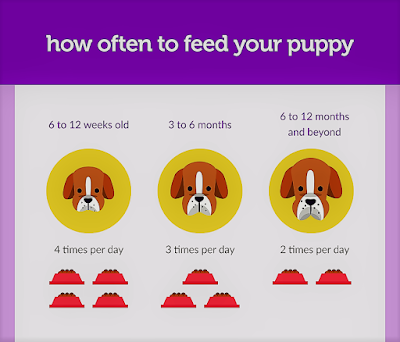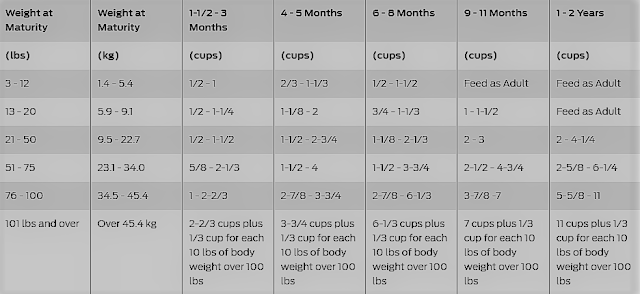Guideline To Feed Your Dogs And Puppies
How much should You feed Your dog?
As you'll see, there's no firm answer to the question "How much should I feed my dog?" you actually got to consider your individual pet's circumstances and conditions before you'll decide what proportion food he really needs.
It's generally an honest policy to start feeding your dog consistent with the advice on the food's label, then track your dog's overall condition to ascertain if this is often the proper amount for him. If your dog seems to take care of his ideal weight, you'll persist with those recommendations.
If your pet loses weight and begins to look too thin, try feeding a touch more, perhaps 1/4 to 1/2 cup more every day, and check his condition again in three to four weeks. you'll get to make further adjustments.
If your dog gains an excessive amount of weight when fed consistent with the brand's recommendations, try decreasing the daily amount you feed by about 1/4 cup and check him again in three to four weeks. If he seems like he features a good ratio of weight to his frame size, you'll continue feeding him that quantity. If not, adjust accordingly and check-in approximately another month.
The idea is to eventually determine the perfect amount you would like to feed your pet to stay him during a healthy condition. So, it is a process of trial and error, but it'll be worth your effort.
How much should You feed Your puppy?
Feeding your puppy a high-quality puppy food helps set him up for an extended and healthy life as an adult dog. This raises tons of questions for first-time (and even veteran) puppy owners, though. what proportion do you have to feed your puppy and when? When do you have to stop feeding puppy food?
Get answers to those questions and more in our complete puppy feeding guide below. Our research answers your questions and offers advice to assist set you and your puppy up for fulfillment.
What to Feed Your Puppy?
When it involves feeding puppies, there are tons of things to think about. Overall nutrition, breed size and therefore the sort of food all play a task. Here’s what you would like to know:
Puppy Nutrition
Puppies need puppy food. Feeding puppies an entire and balanced puppy food ensure they get the right nutrition to develop and grow into healthy adult dogs.
Puppy foods are formulated with a balance of nutrients to assist puppies to get older healthy and happy. search for protein-rich formulas to support their growing muscles. Carbohydrates supply the energy active and playful puppies need, while calcium supports developing teeth and bones and DHA helps support healthy brain and vision development.
Feeding Puppies Large & Small
Not only do puppies need puppy food, but certain breed sizes can enjoy size-specific formulas.
If you've got an outsized breed puppy, he may enjoy an outsized breed-specific puppy formula. Small breeds also can enjoy small breed-specific puppy formulas. no matter breed size, the food should be complete and balanced for growing puppies.
The difference in formulas comes right down to the unique needs of huge and little breeds. Large dogs have a better risk of joint problems, so an outsized breed puppy food may include additional nutrients to support their growing joints.
Small breeds may prefer smaller kibble in order that they can more easily chew their food, which helps ensure they get all the nutrients they have.
According to Purina Senior Nutritionist Jan Dempsey,
“Small breeds have a better rate than larger breeds. this suggests they have more nutrient-dense, higher-energy food, and therefore the same is true for little breed puppies. That’s why it’s important to feed specific small breed puppy and adult formulas.”Dry vs. Wet Puppy Food
Although dry kibble may be a popular choice, it’s not the sole option. As you walk the pet food aisles, you'll see both dry and wet puppy food.
This can make it harder to make a decision on what to feed your puppy. Fortunately, as long as both the wet and dry formulas are complete and balanced for growing puppies, you'll feed either one to your pup confidently.
You and your puppy may have a preference when it involves dry vs. wet. Feeding a mixture of the 2 is additionally an option.
If you select to feed a mixture of the 2, make sure the combined amounts don’t exceed your puppy’s daily recommended caloric intake. Your veterinarian and therefore the chart below can assist you to navigate what proportion to feed your puppy.
“When feeding a mixture of dry and wet food, you would like to work out the daily dry amount and therefore the number of calories this provides first,” says Dempsey. “In general, one three-ounce can of wet food has ninety calories and equals approximately 1 / 4 cup of dry food. So, you ought to substitute a three-ounce can of wet food for 1 / 4 cup of the daily dry food amount.
How Much to Feed Your Puppy?
Now you recognize what to feed your puppy, but just what proportion food does he need each day? Because puppies grow at such fast rates, they have to start out eating an entire and balanced puppy food as soon as they’re weaned, usually between six and eight weeks.The amount of food your puppy needs depends on what proportion he’ll weigh at maturity. A Labrador retriever will weigh more at maturity than a Russell Terrier, for instance. therefore the larger dog requires more food as a puppy.
The chart below can assist you to determine what proportion of dry food to feed your puppy. you ought to also review the precise feeding instructions on the rear of his puppy food and consult your veterinarian.
Puppy feeding chart
When to Feed Your Puppy?
Once you recognize the daily feeding amount, you would like to make a puppy feeding schedule. Take the entire amount of food your puppy needs every day and divide that into a series of smaller feedings. Give those smaller amounts to him at regular intervals every day.
An easy puppy feeding schedule to follow is to feed him once you eat—at breakfast, lunch, and dinner.
Remember to feed him early within the evenings so he has time to digest his food before bedtime. this will help prevent accidents inside. Consistency is vital. Feeding puppies at consistent times every day helps them get won't to the routine.
When to Prevent Feeding Puppy Food?
Eventually, you’ll get to stop feeding puppy food and switch him to an entire and balanced adult pet food.
This transition is dictated by breed size, even as the quantity to feed a puppy depends on his breed. Larger breeds may take longer to succeed in full maturity, so he may have puppy food for up to 2 years.
In general, however, expect to form the transition to adult pet food between one and two years aged.
Talk together with your veterinarian to work out the proper time to form the switch and for recommendations on making the change easy on your pup.
What about Puppy Treats?
How are you able to resist rewarding your puppy with some tasty treats? actually, treats make an efficient training tool.
It’s important to stay the 90/10 rule out mind, whether you’re rewarding your puppy permanently behavior or simply want him to feel loved. consistent with Dempsey, 90 percent of his daily calories should come from his complete and balanced puppy food. the opposite 10 percent can come from treats.
Following the 90/10 rule can help prevent weight gain and other health problems in adulthood.
Those puppy eyes are hard to resist, but remember, you’re building—and training—a dog. Don’t concede to feeding him human food when he begs. Not only are some human foods toxic to dogs, but you’re rewarding undesirable behaviors, which can be harder to interrupt afterward.
By referencing the puppy feeding chart above and following the 90/10 rule, you'll set your pup up for an extended, healthy and happy life with you.















Thanks for this great post, i find it very interesting and very well out and put together. I look forward to reading your work in the future
ReplyDeleteBuy Best Bully sticks